

| "…an individual life [is a] serialized small-scale capitalist crisis. Life's a soap--when it's not a disaster with your name written on it." From the essay, Everywhere You Want To Be, by Brian Massumi, Communications Department, University of Montreal, 1993. |
Political Lying
October 24, 2006
 n the early 1970's, the Communist
government of the German Democratic Republic (GDR) decided, despite being
perennially strapped for resources, to design and construct a building that
could serve as an appropriate symbol of their rule of that small country. The
GDR was sandwiched between the US-financed, rabidly anti-communist, and
Nazi-riddled West Germany (formally, the Federal Republic of Germany) and
Communist Poland.
n the early 1970's, the Communist
government of the German Democratic Republic (GDR) decided, despite being
perennially strapped for resources, to design and construct a building that
could serve as an appropriate symbol of their rule of that small country. The
GDR was sandwiched between the US-financed, rabidly anti-communist, and
Nazi-riddled West Germany (formally, the Federal Republic of Germany) and
Communist Poland.
The site they chose was occupied by the bombed out shell of a palace built by the German Hohenzollern monarchy. The monarchy ended when the last king (Wilhem II) abdicated during the German revolution in November 1918 and the palace was bombed into rubble in WW2. The rubble on this choice piece of real estate in the center of Berlin was cleared and the Palast der Republik was completed on April 23, 1976 and opened to the public two days later.
The Palast was a symbol of German Communism and as such sought to visibly incorporate the ideals of its founders, Rosa Luxemburg and Karl Liebknecht. To this end the north and south walls of the main foyer on two levels were decorated with 16 paintings by contemporary German artists. A few of these can be glimpsed in the photo of the main foyer in the lower left panel below.
| Palace of the Republic of the German Democratic Republic | |
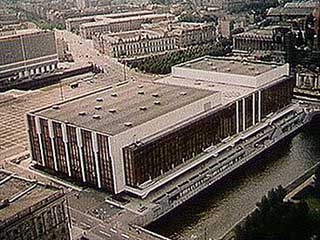
Aerial View |
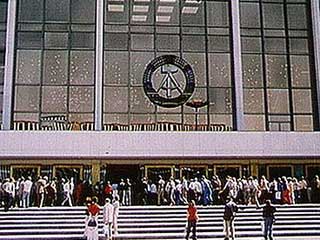
Opening day, April 25, 1976 |
|
| |

Main entrance foyer |
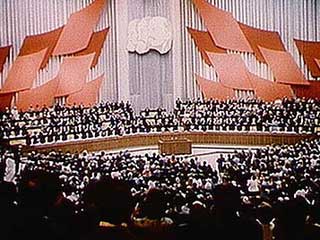
Auditorium |
Two of these paintings are shown below.
| Two of 16 Paintings on Display in the Palast |
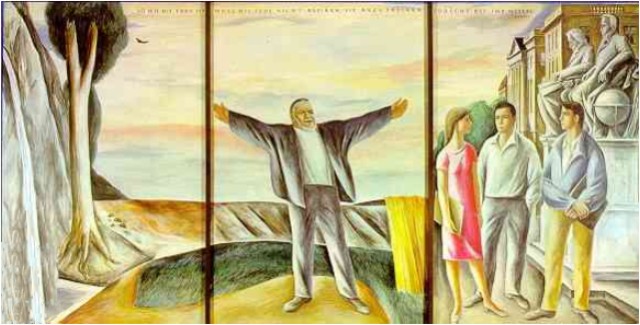
Arno Mohr (1910-2001): Research Until You Know, 1975,
110x217 inches, mixed media on fiberboard.
|

Kurt Robbel (1909-1986): The Working Forces, 1975/76,
110x63/107/63 inches, mixed media on fiberboard. |
In 1990, the German Democratic Republic was annexed by West Germany with no resistance from the GDR's military forces. And in what is by now a familiar process, the West German anti-communists began immediately to destroy the visible symbols of the old regime. The first step was the closing of the Palast der Republik and the removal of the GDR's official seal from the front of the building.
And this is where it gets interesting: How are you going to explain the closing of this nice building to the former East Germans?
You could tell the truth. Like: We hate Communism. The Palast is a symbol of Communism. If it turns out that you don't like Capitalism it could become a rallying point for your dissatisfaction and lead to a resurgence of Communism. That's too much Democracy, so we're going to destroy the building.
Nope. That's not what they said.
They said: The Palast has asbestos in it. If you went into it, it might endanger your health and since we're so concerned about your health we're going to destroy it.
So, for 16 years they left the building empty and un-maintained until it became an eyesore and early in 2006 they started tearing it down.
The two pictures below show what it looked like in 2004 and after the deconstruction had begun in the spring of 2006.
| Palast After GDR's Annexation by West Germany | |
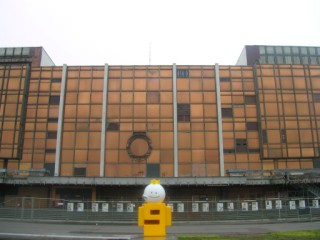
December 31, 2004 |
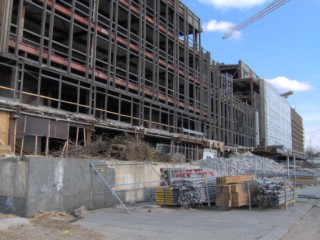
April 9, 2006 |
That's almost, but not quite, the end of the story.
The end of the story comes today, October 24, 2006.
A video clip the NY Times posted on its website today reports on a fatal case of sarcoidosis, a disease which attacks the lungs and which might be caused or aggravated by inhaling toxic dust.
The victim was Mrs. Felicia Dunn-Jones, a black woman and a resident of Staten Island in her mid-30's, who worked in a building near the World Trade Center. On 9-11-01, after the WTC collapsed, Felicia staggered out of her building and into a dense cloud of toxic dust, trying to grope her way back to the Staten Island Ferry so she could get home. She got home by nightfall.
In the subsequent months she developed a persistent cough and by February of the following year her lungs stopped working and she died.
This is what the Mayo Clinic says about sarcoidosis:
Sarcoidosis is an inflammatory disease that starts in your lungs, but in time it can affect virtually any organ in your body, including your liver, skin, heart, nervous system and eyes. Some people have signs and symptoms related to a specific organ, such as shortness of breath from lung problems, but others may have only a vague feeling of illness or no signs or symptoms at all.Although anyone can develop sarcoidosis, the disease mainly affects adults between the ages of 20 and 40. People of Scandinavian descent and black Americans are particularly at risk. Blacks are also more likely to have severe, chronic symptoms than are whites.
Doctors do know that sarcoidosis often goes away on its own without treatment — usually within two to three years. Some people may have symptoms for a lifetime, however. And in rare cases sarcoidosis can be fatal.
Besides being an excellent report on the WTC toxic dust issue, the Times' video tells us what the major toxins in that dust were. A transcript of the relevant part of the narrative and five frames from the video are reproduced here:
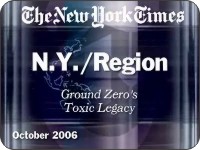
|

|
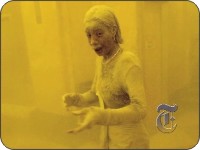
|
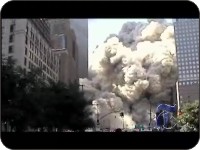
|
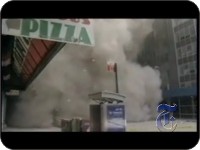
|
The World Trade Center buildings contained …400 thousands pounds of asbestos.
And this is where the loop closes and we can derive a fundamental principle.
Asbestos in a Communist building is cause enough to tear it down while the same in a Capitalist building is no problem at all.
An interesting sidelight to this principle is that Hermann Goering's Nazi Air Ministry building now houses Germany's Finance Ministry. The issue of asbestos in that building has never even come up. Does this suggest an affinity of Capitalism for Hitler's anti-communism?
And more than a sidelight is the fact that for five years after 9-11 the toxic dust problem in NY hardly even came up. From this we can conclude that the Bush regime was more focused on exploiting that event to prepare the country for two wars and the trashing of the constitution than saving American lives.
Which, unless you believe in Jesus's second coming in your lifetime, is hardly news.